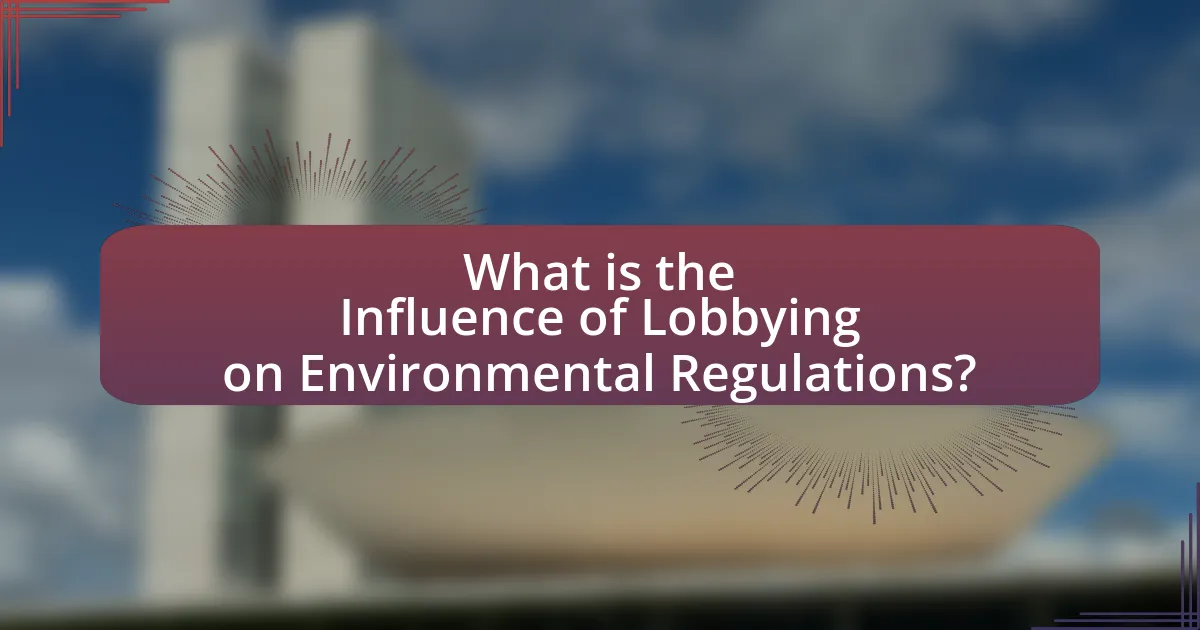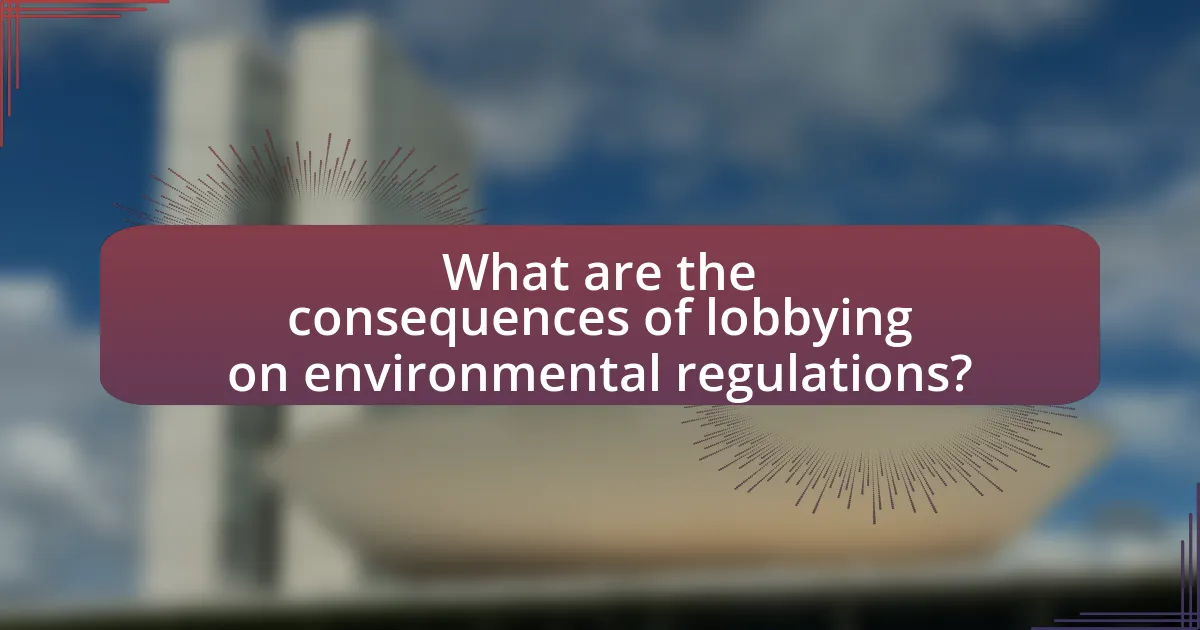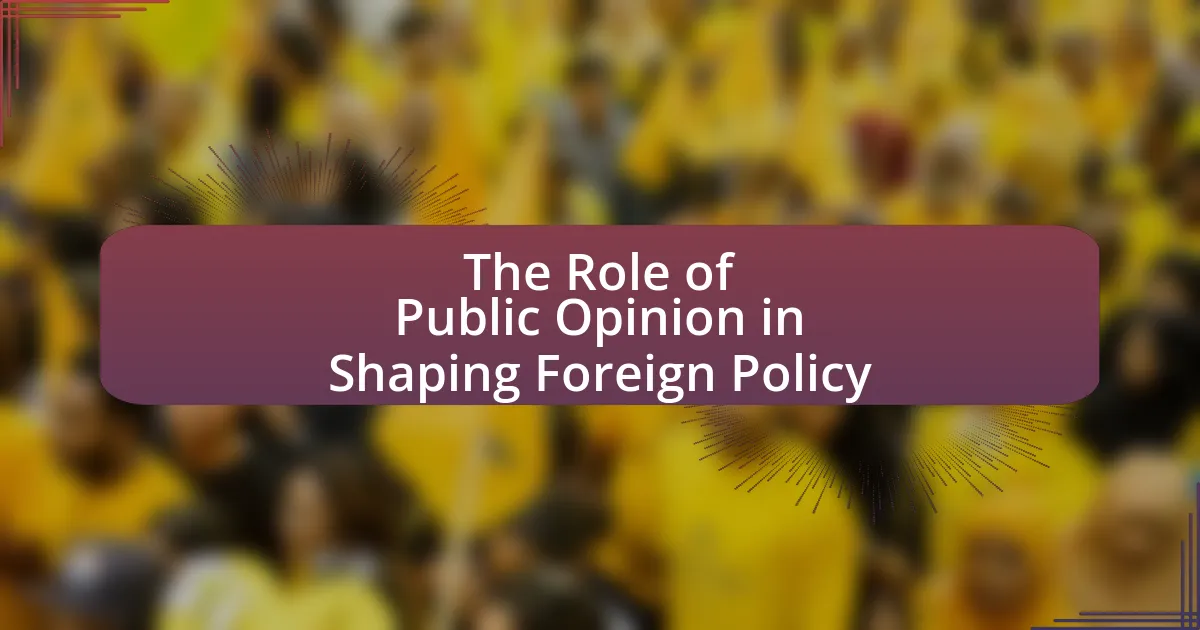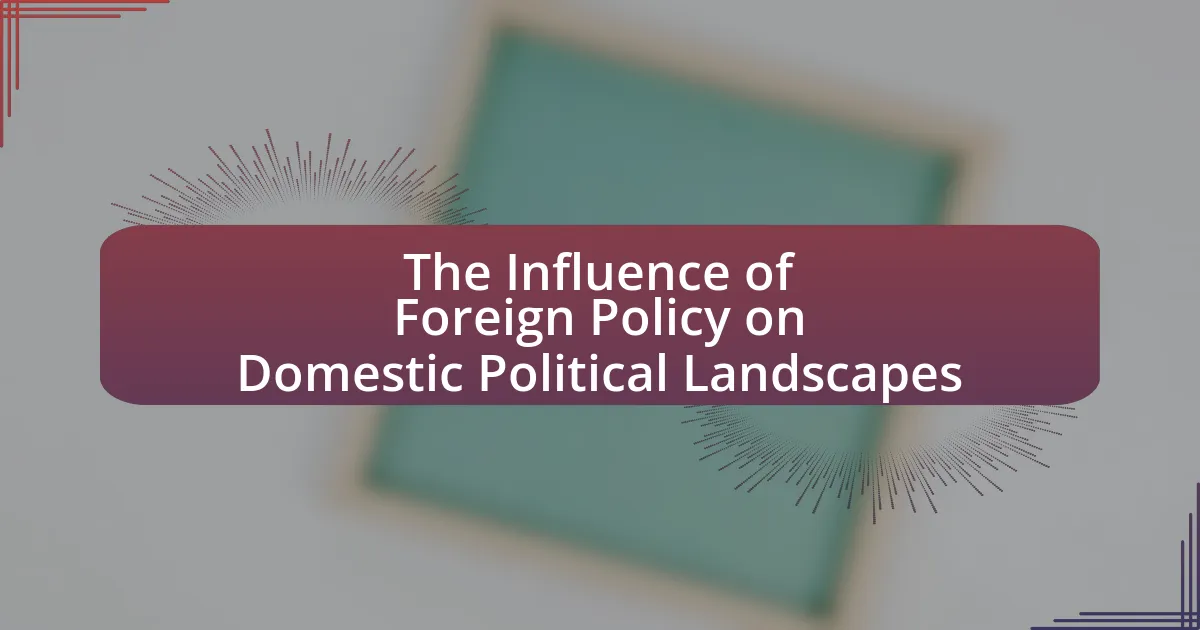The article examines the significant influence of lobbying on environmental regulations, highlighting how corporations and interest groups shape policy outcomes through advocacy and financial support. It details the tactics used by lobbyists, such as direct lobbying and grassroots mobilization, and discusses the prioritization of lobbying efforts in key environmental areas. The article also explores the consequences of lobbying, including regulatory rollbacks and the potential for regulatory capture, while emphasizing the importance of transparency and public engagement in mitigating these effects. Additionally, it outlines best practices for ensuring fair environmental regulation amidst lobbying pressures.

What is the Influence of Lobbying on Environmental Regulations?
Lobbying significantly influences environmental regulations by shaping policy outcomes through advocacy and financial support. Corporations and interest groups often engage in lobbying to promote their agendas, which can lead to weakened regulations or the introduction of favorable policies. For instance, a study by the Center for Responsive Politics found that the fossil fuel industry spent over $1 billion on lobbying from 2000 to 2018, impacting legislation related to climate change and energy production. This financial influence can result in regulatory rollbacks, as seen in the Trump administration’s efforts to dismantle various environmental protections, often driven by lobbying efforts from industry stakeholders.
How does lobbying impact the creation of environmental regulations?
Lobbying significantly influences the creation of environmental regulations by shaping policymakers’ decisions through advocacy and financial support. Interest groups, including corporations and environmental organizations, engage in lobbying to promote their agendas, which can lead to either the weakening or strengthening of regulations. For instance, a study by the Center for Responsive Politics found that the fossil fuel industry spent over $100 million on lobbying in 2020, impacting legislative outcomes related to climate policies. This financial influence can result in regulations that favor industry interests over environmental protection, demonstrating the powerful role of lobbying in the regulatory process.
What are the main tactics used by lobbyists in influencing regulations?
Lobbyists primarily use tactics such as direct lobbying, grassroots mobilization, and coalition building to influence regulations. Direct lobbying involves meeting with lawmakers and their staff to advocate for specific legislative changes, often supported by detailed policy proposals and data. Grassroots mobilization engages the public to contact their representatives, creating pressure for regulatory changes through organized campaigns. Coalition building brings together various stakeholders, including businesses, non-profits, and community groups, to present a united front, amplifying their influence on policymakers. These tactics are effective as they leverage relationships, public opinion, and collective power to shape regulatory outcomes.
How do lobbyists prioritize their efforts in environmental issues?
Lobbyists prioritize their efforts in environmental issues by focusing on key areas such as regulatory frameworks, funding opportunities, and public sentiment. They assess which environmental regulations are most likely to be influenced by their actions, often targeting legislation that has significant economic implications or public visibility. For instance, lobbyists may concentrate on climate change policies, renewable energy incentives, or pollution control measures, as these areas attract substantial public and governmental attention.
Evidence of this prioritization can be seen in the significant financial resources allocated to lobbying efforts; in 2020, the fossil fuel industry alone spent over $100 million on lobbying in the United States, indicating a strategic focus on influencing energy-related regulations. Additionally, lobbyists often utilize data and research to align their priorities with the interests of their clients, ensuring that their efforts are directed toward the most impactful environmental issues.
Why is lobbying significant in the context of environmental policy?
Lobbying is significant in the context of environmental policy because it shapes legislative outcomes and influences regulatory frameworks. Organizations, including corporations and advocacy groups, engage in lobbying to advocate for specific environmental policies that align with their interests, which can lead to the adoption or rejection of regulations. For instance, the American Petroleum Institute has historically lobbied against stringent environmental regulations, impacting policies related to fossil fuel extraction and climate change. This demonstrates how lobbying can directly affect the effectiveness and stringency of environmental protections, ultimately influencing public health and ecological sustainability.
What role do lobbyists play in shaping public perception of environmental issues?
Lobbyists play a significant role in shaping public perception of environmental issues by influencing policy decisions and public discourse. They often represent industries that may be affected by environmental regulations, such as fossil fuels or agriculture, and use strategic communication to frame environmental issues in a way that aligns with their interests. For instance, lobbyists may emphasize economic benefits of certain practices while downplaying environmental risks, thereby swaying public opinion. Research indicates that lobbying efforts can lead to a more favorable public perception of environmentally harmful practices, as seen in the case of the American Petroleum Institute’s campaigns that promote natural gas as a cleaner alternative to coal. This demonstrates how lobbyists can effectively alter the narrative surrounding environmental issues to benefit specific sectors.
How does lobbying affect the balance of power among stakeholders in environmental regulation?
Lobbying significantly shifts the balance of power among stakeholders in environmental regulation by amplifying the voices and interests of specific groups, often at the expense of broader public interests. For instance, industries such as fossil fuels and agriculture frequently engage in lobbying to influence legislation and regulatory frameworks that favor their economic interests, which can lead to weakened environmental protections. Research by the Center for Responsive Politics indicates that in 2020 alone, the fossil fuel industry spent over $100 million on lobbying efforts, demonstrating their capacity to shape policy outcomes. This concentrated influence can marginalize the perspectives of environmental advocacy groups and the general public, thereby skewing regulatory processes in favor of well-funded interests.

What are the different types of lobbying related to environmental regulations?
The different types of lobbying related to environmental regulations include grassroots lobbying, direct lobbying, and coalition lobbying. Grassroots lobbying involves mobilizing the public to contact legislators or government officials to express support or opposition to specific environmental policies. Direct lobbying refers to direct interaction between lobbyists and policymakers to influence legislation or regulatory decisions. Coalition lobbying occurs when multiple organizations or interest groups come together to advocate for a common environmental cause, amplifying their collective influence. Each type plays a significant role in shaping environmental regulations by leveraging public opinion, direct access to decision-makers, and collaborative efforts among various stakeholders.
What are the key categories of lobbying efforts in environmental policy?
The key categories of lobbying efforts in environmental policy include corporate lobbying, grassroots advocacy, and environmental interest groups. Corporate lobbying involves businesses and industries seeking to influence regulations that affect their operations, often focusing on energy, agriculture, and manufacturing sectors. Grassroots advocacy mobilizes public support to influence policymakers, utilizing campaigns that engage citizens in environmental issues. Environmental interest groups, such as non-profits and NGOs, work to promote conservation and sustainability, often lobbying for stricter environmental protections and climate change initiatives. These categories reflect the diverse strategies employed to shape environmental regulations and policies.
How do grassroots lobbying efforts differ from direct lobbying?
Grassroots lobbying efforts differ from direct lobbying in that grassroots lobbying mobilizes the general public to influence policymakers, while direct lobbying involves direct interaction between lobbyists and government officials. Grassroots lobbying aims to create widespread public support or opposition to specific legislation, often utilizing campaigns, social media, and community organizing to engage citizens. In contrast, direct lobbying typically entails professional lobbyists advocating for specific interests through meetings, phone calls, or written communications with legislators and their staff. This distinction is crucial in understanding how different lobbying strategies can impact environmental regulations, as grassroots efforts can amplify public concern over environmental issues, potentially leading to more significant legislative changes.
What is the role of trade associations in environmental lobbying?
Trade associations play a crucial role in environmental lobbying by representing the interests of specific industries and influencing policy decisions related to environmental regulations. These organizations mobilize resources to advocate for favorable legislation, provide expertise on industry practices, and engage in public awareness campaigns to shape perceptions about environmental issues. For instance, the American Petroleum Institute has actively lobbied against stringent environmental regulations, arguing that they could hinder economic growth and energy production. This demonstrates how trade associations leverage their collective power to impact legislative outcomes and regulatory frameworks.
How do lobbying strategies vary across different environmental issues?
Lobbying strategies vary significantly across different environmental issues due to the unique characteristics and stakeholders involved in each issue. For instance, lobbying for climate change legislation often involves a coalition of environmental groups, scientists, and renewable energy companies advocating for comprehensive policies, while lobbying for fossil fuel interests typically focuses on deregulation and tax incentives. The strategies employed reflect the specific goals and opposition faced; for example, water quality advocates may prioritize grassroots mobilization and public awareness campaigns to influence local regulations, whereas wildlife conservation efforts might rely on legal challenges and partnerships with governmental agencies. Evidence of these variations can be seen in the differing funding sources and tactics used by organizations like the Sierra Club, which emphasizes public engagement, versus the American Petroleum Institute, which often employs direct lobbying and political contributions to sway policymakers.
What specific environmental regulations are most influenced by lobbying?
The specific environmental regulations most influenced by lobbying include the Clean Air Act, the Clean Water Act, and the Endangered Species Act. These regulations are frequently targeted by industry groups seeking to modify compliance requirements or reduce regulatory burdens. For instance, the American Petroleum Institute has lobbied extensively to influence air quality standards under the Clean Air Act, arguing for less stringent regulations to promote economic growth. Similarly, agricultural lobbyists have sought changes to the Clean Water Act to limit the scope of federal jurisdiction over water bodies, impacting water quality protections. The Endangered Species Act has also faced significant lobbying efforts from developers and landowners aiming to ease restrictions on land use that protects endangered species habitats.
How do lobbying efforts differ between local, state, and federal levels?
Lobbying efforts differ significantly between local, state, and federal levels due to variations in regulatory frameworks, stakeholder engagement, and the scale of influence. At the local level, lobbying often focuses on specific community issues, such as zoning laws or local environmental regulations, with grassroots organizations frequently leading these efforts. For instance, local environmental groups may lobby city councils to adopt stricter waste management policies.
At the state level, lobbying becomes more organized and involves a broader range of stakeholders, including industry representatives and professional lobbyists. State lobbying efforts often target legislation that impacts environmental regulations across multiple municipalities, such as statewide water quality standards. An example is the lobbying by agricultural associations in various states to influence water usage regulations.
Federal lobbying, on the other hand, encompasses national policies and involves large-scale organizations and corporations with significant resources. Federal lobbying efforts often aim to shape comprehensive environmental legislation, such as the Clean Air Act or the Clean Water Act. For instance, major environmental organizations like the Sierra Club engage in lobbying at the federal level to advocate for climate change legislation.
These differences in lobbying efforts reflect the varying scopes of influence and the specific regulatory contexts at each level of government.

What are the consequences of lobbying on environmental regulations?
Lobbying significantly influences environmental regulations by often leading to weakened protections and increased regulatory rollbacks. For instance, industries such as fossil fuels and agriculture frequently lobby against stringent environmental laws, resulting in legislation that favors economic interests over ecological sustainability. A study by the Center for Responsive Politics found that in 2020, the oil and gas industry spent over $124 million on lobbying efforts, which contributed to the relaxation of regulations like the Clean Power Plan. This demonstrates how lobbying can prioritize corporate profits at the expense of environmental health, ultimately impacting air and water quality and contributing to climate change.
How does lobbying affect the effectiveness of environmental regulations?
Lobbying significantly undermines the effectiveness of environmental regulations by prioritizing corporate interests over ecological protection. For instance, industries often employ lobbyists to influence policymakers, resulting in weakened regulations that favor economic gain at the expense of environmental sustainability. A study by the Center for Responsive Politics found that in 2020, the fossil fuel industry spent over $100 million on lobbying efforts, which contributed to the rollback of key environmental protections. This financial influence can lead to legislation that is less stringent, thereby reducing the overall impact of regulations designed to protect the environment.
What are the potential negative impacts of lobbying on environmental protection?
Lobbying can negatively impact environmental protection by prioritizing corporate interests over ecological sustainability. This often results in weakened regulations, as lobbyists may influence policymakers to relax environmental standards to benefit specific industries, such as fossil fuels or agriculture. For instance, a study by the Center for Responsive Politics found that the oil and gas industry spent over $100 million on lobbying in 2020, which contributed to delays in implementing stricter emissions regulations. Additionally, lobbying can create a disproportionate representation of interests, where well-funded corporations overshadow the voices of environmental advocates, leading to policies that favor economic growth at the expense of environmental health.
How can lobbying lead to regulatory capture in environmental policy?
Lobbying can lead to regulatory capture in environmental policy by allowing special interest groups to exert influence over regulatory agencies, resulting in policies that favor their interests over public welfare. This occurs when lobbyists, often representing industries with significant financial resources, engage in activities such as providing information, funding political campaigns, or establishing close relationships with regulators. For example, the American Petroleum Institute has been known to lobby extensively, which can shape regulations in ways that benefit the oil and gas industry, potentially at the expense of environmental protections. Studies have shown that industries with strong lobbying presence often see more favorable regulatory outcomes, indicating a direct correlation between lobbying efforts and regulatory capture.
What measures can be taken to mitigate the influence of lobbying on environmental regulations?
To mitigate the influence of lobbying on environmental regulations, implementing stricter transparency and disclosure laws is essential. These laws would require lobbyists to publicly disclose their activities, funding sources, and the specific regulations they are attempting to influence. For instance, the Lobbying Disclosure Act in the United States mandates such disclosures, which can help hold lobbyists accountable and inform the public about their activities. Additionally, establishing independent oversight bodies to monitor lobbying activities can further reduce undue influence, as seen in countries like Canada, where the Office of the Commissioner of Lobbying oversees compliance with lobbying regulations. These measures collectively enhance accountability and transparency, thereby reducing the potential for lobbying to skew environmental regulations in favor of special interests.
What role does transparency play in reducing lobbying’s impact on environmental policy?
Transparency plays a crucial role in reducing lobbying’s impact on environmental policy by enabling public scrutiny and accountability. When lobbying activities are transparent, stakeholders, including citizens and advocacy groups, can monitor the interactions between lobbyists and policymakers, which discourages undue influence and promotes ethical behavior. Research indicates that increased transparency in lobbying leads to more informed public discourse and can result in policies that better reflect the public interest rather than special interests. For instance, studies have shown that jurisdictions with stringent lobbying disclosure laws experience lower levels of corruption and more robust environmental regulations, highlighting the effectiveness of transparency in mitigating lobbying’s adverse effects on environmental policy.
How can public engagement counteract the effects of lobbying in environmental regulation?
Public engagement can counteract the effects of lobbying in environmental regulation by increasing transparency and accountability in the decision-making process. When citizens actively participate in discussions, they can raise awareness about environmental issues and challenge the narratives promoted by lobbyists. For instance, public campaigns and grassroots movements have successfully mobilized communities to advocate for stricter environmental protections, as seen in the case of the 2017 protests against the Dakota Access Pipeline, where widespread public opposition influenced regulatory decisions. Additionally, studies show that when public opinion strongly favors environmental regulations, policymakers are more likely to enact those regulations despite lobbying efforts, highlighting the power of collective citizen action in shaping environmental policy.
What best practices can be adopted to ensure fair environmental regulation?
To ensure fair environmental regulation, best practices include implementing transparent decision-making processes, engaging diverse stakeholders, and enforcing strict compliance measures. Transparent decision-making allows for public scrutiny and accountability, which can mitigate undue influence from lobbying groups. Engaging a wide range of stakeholders, including local communities, environmental organizations, and industry representatives, ensures that multiple perspectives are considered, leading to more balanced regulations. Enforcing strict compliance measures, such as regular audits and penalties for violations, reinforces the integrity of environmental regulations and deters non-compliance. These practices collectively promote fairness and equity in environmental governance.





